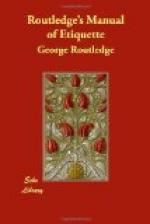The great improvement in muslins and in calicoes—the good patterns which are printed on common linens—have made it quite inexcusable for people to dress ill. Some of the prettiest costumes that we have seen have been made in cheap materials, and persons who have admired them have been quite astonished to find that they have bestowed their admiration upon an “inferior article.”
For autumn wear there are camlets, alpacas, and serge of all colours, which are designated “Yachting and Sea-side Costumes,” but which are suitable for all places. Their effect is exceedingly good, braided or otherwise. They may be got anywhere, though Cowes boasts of having the best assortment. We have seen white braided with black, or with a pattern printed on it in black; blue, light and dark; brown; green braided in white, the effect of which has been good; and we have seen scarlet, which is very trying, and more suited for winter. It is effective when toned down with black velvet, but it looks rather heavy and overpowering.
For winter, there are droguets, reps in worsted and in silk, merinos, tweeds, linseys, and velveteens. We do not mention silk, because it is universally acknowledged that there is nothing so well suited to all seasons. It looks better than anything else, is the pleasantest to wear, and may be procured of almost any substance. Velveteens have a very good effect—better than most materials; and when they are braided well, they are very effective. The black looks the best, and is the most serviceable; and when worn with a mantle, or cloak, or jacket to match, it makes one of the best costumes for walking or driving. The brown velveteen is effective. It is considered warm and light,—two most important qualities for clothing; for, with the amplitude of modern skirts, it is absolutely essential that materials should be light as well as warm.
For spring and summer it is needless to specify more materials than have been already named. The only point to be considered is that in spring, dress should be, in our uncertain climate, suited to changes of weather, and temperature, and should be in harmony with the season when nature is putting on her best apparel, and woods and fields become hourly more green and full of vegetation. In summer, dress should be light and cool and quiet; because, beneath a glowing sun, bright colours do not please, unless they harmonize with the blue sky or green earth.
The second important point in matters of dress is the make or cut. Upon this depends the question whether cheap materials can be worn. An ordinary stuff or calico well made, fashionably made, and well put on, is never out of place. It, not unfrequently, puts to shame many richer materials which are not so well made nor so well selected.




